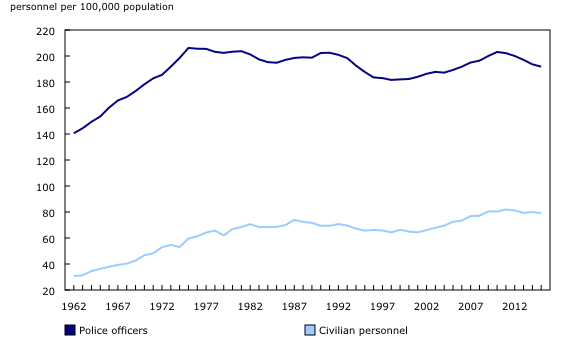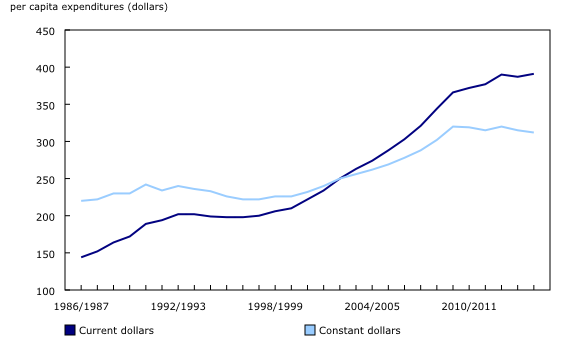Police resources in Canada, 2015
Archived Content
Information identified as archived is provided for reference, research or recordkeeping purposes. It is not subject to the Government of Canada Web Standards and has not been altered or updated since it was archived. Please "contact us" to request a format other than those available.
Released: 2016-03-30
On the snapshot date of May 15, 2015, there were 68,777 police officers in Canada, 29 fewer than in the previous year. The rate of police strength declined 0.9% from the previous year to 192 officers per 100,000 population. After increasing from 1999 to 2010, the rate of police strength in Canada declined for four consecutive years.
The rate of police strength fell in every province in 2015 with the exception of Newfoundland and Labrador, where the rate was stable (-0.4%), and Alberta, where it increased slightly (+0.5%).
In 2015, 5 of 49 police services serving a population of 100,000 or more reported an increase in their rate of police strength. They included three British Columbia communities, Surrey, Burnaby and Langley Township, as well as Lévis, Quebec and Red Deer, Alberta.
The number of female police officers in Canada continued to grow. On May 15, 2015, there were 14,332 female officers, up 1.2% from 2014. Female police officers accounted for one in five (20.8%) of all police officers in 2015. The proportion of female officers employed by Canadian police services has increased annually since data were first collected in 1986.
The proportion of female senior officers, meaning those occupying the ranks of lieutenant to police chief, more than doubled over the last decade, from 5% in 2005 to 12% in 2015.
For the fourth consecutive year, the proportion of officers aged 40 and older increased, rising from 50% in 2012 to 54% in 2015. According to the Police Administration Survey, 5% of police officers in 2015 were 55 years or older. However, eligibility to retire may not be based solely on age and requirements may vary by police service.
In the calendar year or fiscal year 2014/2015, 11% of all police officers in Canada were eligible for retirement, but 3%, or 1,741 officers, opted to retire. Those who did retire accounted for 70% of all police officers who departed from their service.
The 28,368 civilians employed by police services on May 15, 2015, accounted for 29% of total police personnel. The proportion of civilians in policing has gradually increased since data were first collected in 1962. The more recent increase in civilian staff has mainly been driven by the growing number of management/professionals employed by police services.
Year-end operating expenditures for police services in Canada in 2014/2015 totalled $13.9 billion in current dollars. These expenditures comprised salaries and wages (66%), benefits (15%), and other operating expenditures (19%). When adjusting for inflation, police spending increased annually from 1997/1998 to 2010/2011. Since then, police operating expenditures have been relatively stable, and were unchanged in 2014/2015. However, when considering the population of Canada and inflation, policing costs per capita declined 0.9% in 2014/2015. In current dollars, annual police operating expenditures in 2014/2015 totalled $391 for every Canadian.
Note to readers
Several factors may contribute to differences in the rates of police strength across jurisdictions and police services. These include differences in police services' priorities, policies, procedures and enforcement practices, and the availability of resources.
In Canada, information on police personnel and expenditures is collected by Statistics Canada through the annual Police Administration Survey. Using data reported by each police service in Canada, this report provides details on police personnel at the national, provincial and territorial, and respondent levels.
Data in this report represent two distinct time periods. Most of the information on police personnel is based on a "snapshot date" of May 15, 2015, while data on hirings, departures, retirements, eligibility to retire, and expenditures represent the calendar year ending December 31, 2014 (or March 31, 2015 for those police services operating on a fiscal year).
In this release, rates with a percent change that rounds to 0% are considered stable.
Products
The Juristat article "Police resources in Canada, 2015" (85-002-X) is now available. From the Browse by key resource module of our website, under Publications, choose All subjects, then Crime and justice and Juristat.
Contact information
For more information, or to enquire about the concepts, methods or data quality of this release, contact us (toll-free 1-800-263-1136; 514-283-8300; STATCAN.infostats-infostats.STATCAN@canada.ca) or Media Relations (613-951-4636; STATCAN.mediahotline-ligneinfomedias.STATCAN@canada.ca).
- Date modified:



